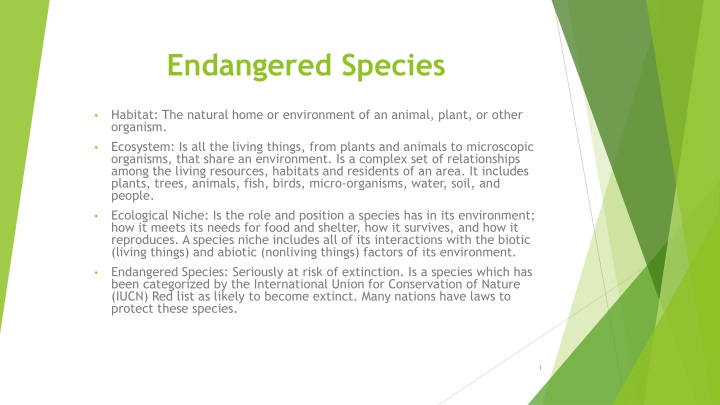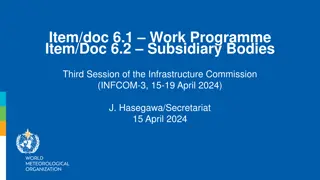
Endangered Species and Ecosystems
Exploring the concepts of endangered species, habitats, ecosystems, and the importance of conservation efforts. Learn about food chains, ecological niches, and the Endangered Species Act of 1973. Discover the role of environmental science and professionals in analyzing threats to biodiversity and habitats.
Download Presentation

Please find below an Image/Link to download the presentation.
The content on the website is provided AS IS for your information and personal use only. It may not be sold, licensed, or shared on other websites without obtaining consent from the author. If you encounter any issues during the download, it is possible that the publisher has removed the file from their server.
You are allowed to download the files provided on this website for personal or commercial use, subject to the condition that they are used lawfully. All files are the property of their respective owners.
The content on the website is provided AS IS for your information and personal use only. It may not be sold, licensed, or shared on other websites without obtaining consent from the author.
E N D
Presentation Transcript
Endangered Species Habitat: The natural home or environment of an animal, plant, or other organism. Ecosystem: Is all the living things, from plants and animals to microscopic organisms, that share an environment. Is a complex set of relationships among the living resources, habitats and residents of an area. It includes plants, trees, animals, fish, birds, micro-organisms, water, soil, and people. Ecological Niche: Is the role and position a species has in its environment; how it meets its needs for food and shelter, how it survives, and how it reproduces. A species niche includes all of its interactions with the biotic (living things) and abiotic (nonliving things) factors of its environment. Endangered Species: Seriously at risk of extinction. Is a species which has been categorized by the International Union for Conservation of Nature (IUCN) Red list as likely to become extinct. Many nations have laws to protect these species. 1
Endangered Species, Contd Food Chain: All living things need energy to stay alive. This energy comes from the sun. Plants make their food from energy from the sun. Animals get their energy from the food they eat. Animals depend on other living things for food. Some animals eat plants while others eat other animals. This passing of energy from the sun to plants to animals to other animals is called a food chain. - 2
Endangered Species, Contd Endangered Species Act (ESA): The ESA of 1973 is a key legislation for both domestic and international conservation. The act provides a framework to conserve and protect endangered and threatened species and their habitats. Endangered any species that is in danger of extinction throughout all or a significant portion of its range. Threatened any species that is likely to become an endangered species within the foreseeable future throughout all or a significant portion of its range. 5
Endangered Species, Contd Role of Environmental Science and Environmental Engineer professionals in the Analysis: Example of Analysis: Are there any threatened or endangered individuals identified on, adjacent to or near the project site? Evaluate loss of habitats, populations or individuals only for those species. What habitats needed by threatened or endangered species are found on the project site? Is the habitat rare? Is the project site part of a larger range that supports an endangered or threatened population? Are there any actions proposed that will reduce the size, structure or other features of the habitats but not totally remove it from the project site? Is there a barrier proposed as part of the action that will hinder or harm key migration patterns? What percentage of the project site contains habitats used by rare, threatened or endangered species and what portion of that will be impacted? Will there be an impact? 6 If there are no rare habitats on the project site, or if no endangered or threatened species are known to be on, adjacent or near the project site, there will be no related impacts.
Endangered Species, Contd Role of Environmental Science and Environmental Engineer professionals in the Analysis: If your activities could impact these species or habitats, you may be required to develop mitigation strategies to minimize the impacts. Prior to construction, you should consult with the local office of the U.S. Fish and Wildlife Service (http://endangered.fws.gov), the National Marine Fisheries Service (www.nmfs.noaa.gov), as well as your local conservation agency, to determine if your project could harm endangered or threatened species, and if so, what to do about it. For information on the Endangered Species Act, go to http://endangere/policies/index.html. Absent any Federal involvement or oversight, private landowners must d.fws.gov still insure that their proposed development activities will not result in a take of any listed species and may need to develop a habitat conservation plan. 1. 7
Endangered Species, Contd For questions/comments about this presentation: Contact: Sowj Chintalapati @ chintalapati1@gmail.com 9


